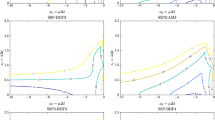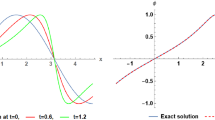Abstract
The main purpose of the paper is to show how to use implicit–explicit Runge–Kutta methods in a much more general context than usually found in the literature, obtaining very effective schemes for a large class of problems. This approach gives a great flexibility, and allows, in many cases the construction of simple linearly implicit schemes without any Newton’s iteration. This is obtained by identifying the (possibly linear) dependence on the unknown of the system which generates the stiffness. Only the stiff dependence is treated implicitly, then making the whole method much simpler than fully implicit ones. The resulting schemes are denoted as semi-implicit R–K. We adopt several semi-implicit R–K methods up to order three. We illustrate the effectiveness of the new approach with many applications to reaction–diffusion, convection diffusion and nonlinear diffusion system of equations.









Similar content being viewed by others
References
Caflisch, R.E., Jin, S., Russo, G.: Uniformly accurate schemes for hyperbolic systems with relaxation. SIAM J. Numer. Anal. 34(1), 246–281 (2001)
Carpenter, M.H., Kennedy, C.A.: Additive Runge–Kutta schemes for convection–diffusion–reaction equations. Appl. Numer. Math. 44, 139–181 (2003)
Chen, C.Q., Levermore, C.D., Liu, T.P.: Hyperbolic conservation laws with relaxation terms and entropy. Commun. Pure Appl. Math. 47, 787–830 (1994)
Durran, D.R., Blossey, P.N.: Implicit–explicit multistep methods for fast-wave–slow-wave problems. Mon. Wea. Rev. 140, 1307–1325 (2012)
Jin, S.: Runge–Kutta methods for hyperbolic conservation laws with stiff relaxation terms. J. Comput. Phys. 122, 51–67 (1995)
Pareschi, L., Russo, G.: Implicit–explicit Runge–Kutta schemes for stiff systems of differential equations. In: Trigiante, D. (ed.) Recent Trends in Numerical Analysis, Advances Theory Computational Mathematics, vol. 3, pp. 269–288. Nova Sci. Publ., Huntington, NY (2001)
Pareschi, L., Russo, G.: Implicit–explicit Runge–Kutta schemes and applications to hyperbolic systems with relaxations. J. Sci. Comput. 25, 129–155 (2005)
Weller, H., Lock, S.J., Wood, N.: Runge–Kutta IMEX schemes for the horizontally explicit/vertically implicit (HEVI) solution of wave equations. J. Comput. Phys. 252, 365–381 (2013)
Hairer, E., Wanner, G.: Solving ordinary differential equation. II. Stiff and differential algebraic problems, Springer Series in Computational Mathematics, 14, Springer (second revised edition 1996), corrected second printing 2002
Higueras, I., Mantas, J.M., Roldán, T.: Design and implementation of predictors for additive semi-implicit Runge–Kutta methods. SIAM J. Sci. Comput. 31(3), 2131–2150 (2009)
Zhong, X.: Additive semi-implicit Runge–Kutta methods for computing high-speed non equilibrium reactive flows. J. Comput. Phys. 128, 19–31 (1996)
Boscarino, S., LeFloch, P.-G., Russo, G.: High-order asymptotic-preserving methods for fully non linear relaxation problems. SIAM J. Sci. Comput. 36, A377–A395 (2014)
Berthon, C., LeFloch, P.-G., Turpault, R.: Late-time relaxation limits of nonlinear hyperbolic systems. A general framework. Math. Comput. 82, 831–860 (2012)
Smereka, P.: Semi-implicit level set methods for curvature and surface diffusion motion. J. Sci. Comput. 19(1–3), 439–456 (2003)
Filbet, F., Jin, S.: A class of asymptotic-preserving schemes for kinetic equations and related problems with stiff sources. J. Comput. Phys. 229, 7625–7648 (2010)
Giraldo, F.X., Restelli, M., Läuter, M.: Semi-implicit formulations of the Navier–Stokes equations: application to nonhydrostatic atmosphereric modeling. SIAM J. Sci. Comput. 32(6), 3394–3425 (2010)
Giraldo, F.X., Kelly, J.F., Costantinescu, E.M.: Implicit–explicit formulations of a three-dimensional nonhydrostatic unified model of the atmosphere (NUMA). SIAM J. Sci. Comput. 35(5), B1162–B1194 (2013)
Araújo, A., Barbeiro, S., Serranho, P.: Stability of finite difference schemes for complex diffusion processes. SIAM J. Numer. Anal. 50, 1284–1296 (2012)
Boscarino, S., Russo, G.: High-order asymptotic-preserving methods for nonlinear relaxation from hyperbolic systems to convection–diffusion equations. In: Submitted to Proceedings, High Order Nonlinear Numerical Methods for Evolutionary PDEs (HONOM 2013), March 18–22, Bordeaux (2013)
Boscarino, S., Bürger, R., Mulet, Pep, Russo, G., Villada, L.M.: Linearly implicit IMEX Runge–Kutta methods for a class of degenerate convection–diffusion problems. SIAM J. Sci. Comput. 37, B305–B331 (2015)
Hairer, E., Norsett, S.P., Wanner, G.: Solving Ordinary Differential Equation. I. Non-stiff Problems, Springer Series in Computational Mathematics, vol. 8. Springer, Berlin (1993)
Ascher, U., Ruuth, S., Spiteri, R.J.: Implicit–explicit Runge–Kutta methods for time dependent partial differential equations. Appl. Numer. Math. 25, 151–167 (1997)
Boscarino, S.: Error analysis of IMEX Runge–Kutta methods derived from differential algebraic systems. SIAM J. Numer. Anal. 45, 1600–1621 (2007)
Boscarino, S.: On an accurate third order implicit–explicit Runge–Kutta method for stiff problems. Appl. Numer. Math. 59, 1515–1528 (2009)
Boscarino, S., Russo, G.: Flux-explicit IMEX Runge–Kutta schemes for hyperbolic to parabolic relaxation problems. SIAM J. Numer. Anal. 51, 163–190 (2013)
Hairer, E., Lubich, C., Roche, M.: Error of Runge–Kutta methods for stiff problems studied via differential algebraic equations. BIT Numer. Math. 28(3), 678–700 (1988)
Filbet, F., Guo, R., Xu, Y.: Efficient high order semi-implicit time discretization and local discontinuous Galerkin methods for highly nonlinear PDEs. Preprint (2015)
Filbet, F., Rodrigues, L.M.: Asymptotically stable particle-in-cell methods for the Vlasov–Poisson system with a strong external magnetic field. Preprint (2015)
Hairer, E., Lubich, C., Wanner, G.: Geometric Numerical Integration. Structure-Preserving Algorithms for Ordinary Differential Equations, Springer Series in Computational Mathematics, vol. 31, 2nd edn. Springer, Berlin (2006)
Gottlieb, S., Shu, C.W., Tadmor, E.: Strong stability-preserving high-order time discretization methods. SIAM Rev. 43, 89–112 (2001)
Boscarino, S., Russo, G.: On a class of uniformly accurate IMEX Runge–Kutta schemes and application to hyperbolic systems with relaxation. SIAM J. Sci. Comput. 31, 1926–1945 (2009)
Higueras, I., Roldán, T.: Construction of additive semi-implicit Runge–Kutta methods with low-storage requirements. J. Sci. Comput. (2015). doi:10.1007/s10915-015-0116-2
Filbet, F., Rambaud, A.: Analysis of an asymptotic preserving scheme for relaxation systems. ESAIM Math. Model. Numer. Anal. 47, 609–633 (2013)
Zhang, K., Wong, J.C.F., Zhang, R.: Second-order implicit–explicit scheme for the Gray–Scott model. J. Comput. Appl. Math. 213, 559–581 (2008)
Carrillo, J.A., Laurençot, Ph, Rosado, J.: Fermi–Dirac–Fokker–Planck equation: well-posedness and long-time asymptotics. J. Differ. Equ. 247, 2209–2234 (2009)
Carrillo, J.A., Rosado, J., Salvarani, F.: 1D nonlinear Fokker–Planck equations for fermions and bosons. Appl. Math. Lett. 21, 148–154 (2008)
Bessemoulin-Chatard, M., Filbet, F.: A finite volume scheme for nonlinear degenerate parabolic equations. SIAM J. Sci. Comput. 34, 559–583 (2012)
Bertozzi, A.L.: The mathematics of moving contact lines in thin liquid films. Not. AMS 45, 689–697 (1998)
Pareschi, L., Russo, G., Toscani, G.: A kinetic approximation to Hele–Shaw flow. C. R. Math., Acad. Sci. Paris, Ser. I 338(2), 178–182 (2004)
Bertozzi, A.L., Pugh, M.: The lubrication approximation for thin viscous films: regularity and long-time behavior of weak solutions. Commun. Pure Appl. Math. XLIX, 85–123 (1996)
Deckelnick, K., Dziuk, G., Elliott, C.M.: Computation of geometric partial differential equations and mean curvature flow. Acta Numer. 14, 139–232 (2005)
Xu, Y., Shu, C.W.: Local discontinuous Galerkin method for surface diffusion and Willmore flow of graphs. J. Sci. Comput. 40, 375–390 (2009)
Acknowledgments
Francis Filbet is partially supported by the European Research Council ERC Starting Grant 2009, Project 239983-NuSiKiMo and the French ANR project STAB. Giovanni Russo and Sebastiano Boscarino have been partially supported by Italian PRIN 2009 project “Innovative numerical methods for hyperbolic problems with application to fluid dynamics, kinetic theory, and computational biology”, Prot. No. 2009588FHJ.
Author information
Authors and Affiliations
Corresponding author
Appendix
Appendix
Here we prove that it is possible to apply the IMEX schemes to the general system (8) with no doubling of the stage fluxes. We start observing that by choosing \(\hat{y}=(t,u)\) and \(z=u\), we can rewrite system (1) as
with initial conditions \(\hat{y}(t_0) = (t_0,u_0)\), \(z(t_0) = u_0\).
In this way, system (37) for \((\hat{y},z)\) is a particular case of an autonomous partitioned system in which \(\mathcal {F}_1=(1, \mathcal {H})\) and \(\mathcal {F}_2=\mathcal {H}\) but apparently with an additional computational cost since we double the number of variables. Now, we apply the partitioned Runge–Kutta method (6)–(7) to (37) obtaining
with
Using the assumption (5), that is, \(\sum _j \hat{a}_{i,j}=\hat{c}_i\), we obtain that the first component of \({\hat{Y}}\) at the stage i is equal to \(t^n+{\hat{c}}_i\Delta t\), and therefore, under the consistency condition \(\sum _i {\hat{b}}_i=1\), the first component of \({\hat{y}}\) at time \(t^{n+1}\) is equal to time \(t^{n+1}\).
Replacing \(\hat{y}\) by (t, y), we have
with
Equation (38) already shows that \(k_i=\ell _i, i=1,\ldots , s\). The numerical solutions at the next time step are
At this stage let us address several issues: number of evaluations, storage, order of accuracy and embedded methods.
Remark 5.1
Concerning the number of evaluations of \(\mathcal {H}\), we observe that by writing \((\mathcal {G})\) as an autonomous partitioned system, we have \(\ell _i=k_i\) for all \(1\le i\le s\). Therefore only one evaluation of \(\mathcal {H}\) is needed in (38), and only one set of stage fluxes is computed. Note that in (37), we could also choose \(y=u\) and \(\hat{z} = (t,u)\) and therefore use the \((c_i)_i\) coefficients for time stages.
Rights and permissions
About this article
Cite this article
Boscarino, S., Filbet, F. & Russo, G. High Order Semi-implicit Schemes for Time Dependent Partial Differential Equations. J Sci Comput 68, 975–1001 (2016). https://doi.org/10.1007/s10915-016-0168-y
Received:
Revised:
Accepted:
Published:
Issue Date:
DOI: https://doi.org/10.1007/s10915-016-0168-y




